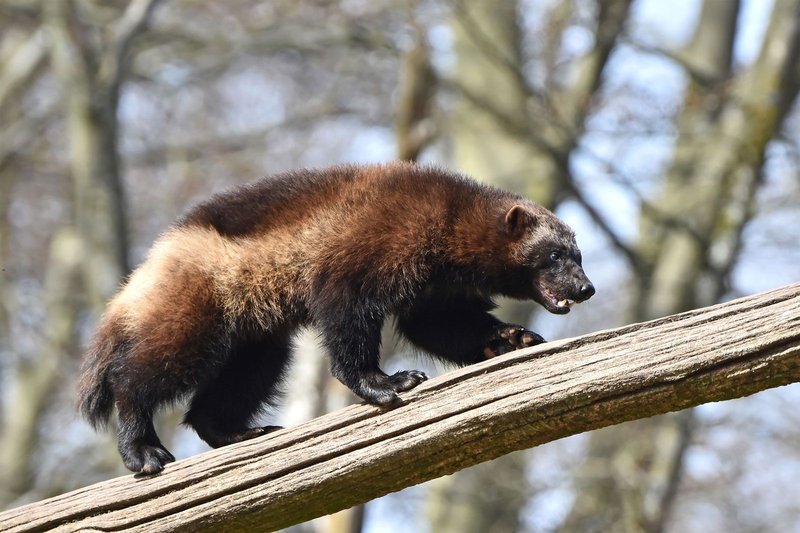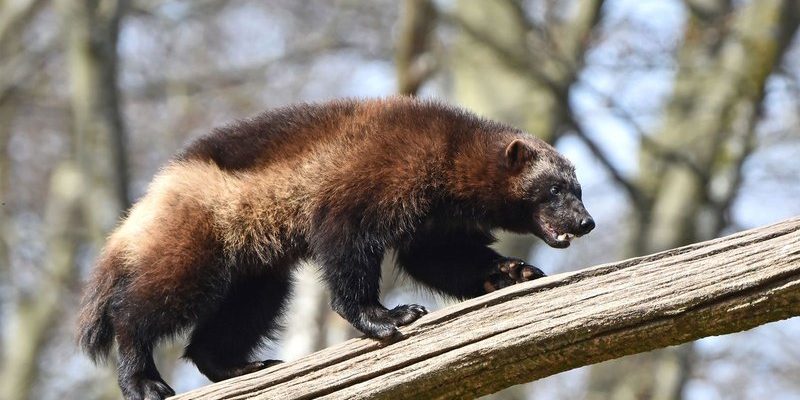
The wolverine is one tough little critter. Often mistaken for a badger or even a small bear, this feisty animal is a member of the weasel family and packs a surprising punch in the wild. Imagine a stocky creature with a bushy tail, a broad head, and powerful limbs. These animals thrive in some of the harshest conditions on earth, primarily roaming the cold, rugged terrain of the Arctic and subarctic regions. They might not be as famous as majestic wolves or fierce bears, but the wolverine has a story worth sharing.
Despite their fierce appearance and bold demeanor, wolverines are actually quite elusive. They prefer solitude and tend to keep to themselves, which makes spotting one in the wild a rare treat. With a penchant for scavenging and an easier-to-miss presence, these animals are often overshadowed by larger, more charismatic wildlife. But here’s the thing: wolverines are nature’s ultimate survivors, equipped with some fascinating adaptations that help them thrive in extreme conditions.
Physical Characteristics
Wolverines come with unique and striking characteristics that make them easily identifiable. Generally, they measure about 26 to 34 inches in length, with tails adding another 8 to 10 inches. Their weight ranges widely, typically falling between 24 to 40 pounds, depending on factors like diet and habitat. What makes them remarkable is their stocky build, reinforced by strong legs and massive claws that allow them to dig through snow for food—almost like tiny bulldozers! Their fur is thick, dense, and luxurious, usually dark brown or black, with lighter stripes or patches along their sides, making them quite the fashionable survivor in the wild.
One thing to note is their incredible sense of smell, which is vital for locating food beneath deep snow. It’s as if they have a built-in GPS, expertly guiding them toward their next meal. Their eyesight isn’t their strongest suit, but their keen hearing compensates for that, letting them detect even the faintest rustle of prey. Wolverines are also known for their muscular build, which gives them the strength to tackle prey much larger than themselves, proving that you shouldn’t judge a book by its cover.
Habitat and Distribution
Wolverines are most commonly found in cold, snowy environments, which suits their thick fur and other adaptations perfectly. They typically inhabit boreal forests, alpine regions, and tundra—places where few other animals can endure such harsh conditions. Their range spans across North America, Europe, and parts of Asia. Think of the rugged mountains and vast wilderness areas; that’s where you’ll find these feisty creatures, camouflaged against the snow and trees.
In North America, they can be spotted in Alaska, Canada, and the northern parts of the continental United States, such as Montana and some areas of the Rocky Mountains. As their habitat shrinks due to climate change, their populations have become isolated within these regions, making it even more critical to protect their natural homes. Wolverines are highly territorial and follow vast ranges, often traveling more than 30 miles in search of food and mates. This wanderlust means they’re on the move more than you might think.
Diet and Hunting Behavior
Wolverines are omnivorous scavengers, which means they eat a mixed diet, making the most of what their rugged environment offers. Their diet primarily consists of small mammals, carrion, and, occasionally, plants. Yes, you read that right; they are not picky eaters! Found rummaging for leftovers from larger predators like wolves and bears, they often dine on animal carcasses, showcasing their resourcefulness. They have even been known to hunt down prey like snowshoe hares, squirrels, and birds when the opportunity arises.
What’s particularly fascinating is their hunting strategy. Wolverines use their strength and sharp claws to dig through thick snow, hunting for hidden prey. They rely heavily on their sense of smell to locate food buried beneath the snow. Once they find something, they can dig quickly, often uncovering a feast. They can consume a large meal in one sitting. Sometimes, they will stash food for later, keeping it hidden under layers of snow, a clever tactic that shows their foresight and planning skills.
Behavior and Social Structure
Wolverines are solitary animals, except during mating season or when mothers are raising their young. They establish large territories that they patrol regularly, marking them with scent to ward off other wolverines. Imagine a small furry body, strutting confidently through the snow, claiming its space—it’s a sight to behold! They’re not just loners by chance; their individualistic nature allows them to be highly effective hunters in the wild.
Mating typically occurs in the summer, with females giving birth to 2 to 3 kits during the spring after a gestation period of about 30 days. These adorable little ones are born blind and helpless, relying entirely on their mother for survival. Interestingly, wolverine mothers are fiercely protective, ensuring their kits are nurtured and safe as they grow. As the kits mature, they become adept at hunting and foraging, quickly learning the tricks of survival from their strong-willed moms.
Conservation Status
Wolverines face several threats that have led to increasing concern over their populations. Habitat loss due to climate change, development, and resource extraction poses a significant risk to their survival. As temperatures rise, their cold, snowy habitats are shrinking, which can impact their hunting and breeding grounds. Additionally, they face pressures from hunting and trapping, making their populations even more vulnerable.
Many conservation efforts are in place to protect these incredible creatures. Organizations are working tirelessly to create protected areas and promote awareness about the importance of preserving wolverine habitats. These initiatives are crucial for maintaining genetic diversity and ensuring that these resilient animals continue to thrive in their natural environments. Local communities are also being encouraged to participate in conservation, understanding that preserving wolverines can have a positive ripple effect on the entire ecosystem.
| Characteristic | Details |
|---|---|
| Size | 26 to 34 inches long with tails of 8 to 10 inches |
| Weight | 24 to 40 pounds |
| Habitat | Boreal forests, alpine regions, tundra |
| Diet | Omnivorous; small mammals, carrion, plants |
| Lifespan | Up to 10 years in the wild |
The wolverine is a fascinating creature that embodies resilience and adaptability. With their unique characteristics and survival strategies, they continue to thrive in challenging environments. As we learn more about these incredible animals, it’s important to recognize the threats they face and take action to protect their habitats. They may not be the largest or most well-known mammals, but wolverines deserve our respect and attention. Next time you think of wildlife, remember the tenacious wolverine—the underdog of the animal world!
FAQ
What is the habitat of a wolverine?
Wolverines predominantly inhabit cold, snowy environments, thriving in regions such as boreal forests, alpine areas, and tundra. They are well-adapted to extreme climates and prefer places where they can find ample food sources, like small mammals and carrion. In North America, you can typically find them in places like Alaska, Canada, and parts of the northern United States. Their territories are quite large, allowing them to roam and search for food efficiently.
Are wolverines aggressive towards humans?
While wolverines can be fierce and aggressive when threatened, they tend to avoid human contact. These animals are inherently cautious, preferring to stay hidden in their rugged environments. Attacks on humans are extremely rare and usually occur only if a wolverine feels cornered. Overall, they are more interested in keeping to themselves and focusing on survival.
What do wolverines eat?
Wolverines are omnivores, meaning they eat a variety of foods. Their diet mainly consists of small mammals like snowshoe hares, squirrels, and the carcasses left behind by larger predators. They’re known scavengers and can consume a substantial amount of food in one sitting, storing leftovers under the snow for later. Their resourceful nature helps them adapt to the scarcity often present in their harsh habitats.
How fast can wolverines run?
Although they are not built for speed like some other carnivorous animals, wolverines are surprisingly agile for their size. They can run up to 30 miles per hour in short bursts, especially when they feel threatened or are chasing prey. This combination of strength and speed allows them to navigate their often rugged and snowy environments with relative ease.
What is the wolverine’s life expectancy?
In the wild, wolverines typically live up to around 10 years, although some may live longer in protected environments. Their lifespan can be influenced by factors like habitat quality, food availability, and threats from other predators or human activities. In captivity, with proper care and resources, they can live even longer.
How do wolverines communicate?
Wolverines communicate using a mix of vocalizations and body language. They can produce a variety of sounds, including growls, whines, and even purrs, especially during mating season. Scent marking is a key part of their communication as well, helping establish territory and attract mates. Through these various methods, they can effectively convey their needs and intentions to other wolverines.
Are wolverines social animals?
Wolverines are generally solitary creatures, preferring to live and hunt alone. They come together primarily for mating and raising young. This solitary lifestyle allows them to be highly efficient hunters and helps avoid competition for food resources. However, during mating season, males and females will briefly interact before often returning to their independent ways.
What are the major threats to wolverine populations?
The primary threats to wolverine populations include habitat loss from climate change, urban development, and resource extraction. As their cold habitats warm, finding food and suitable places to breed becomes more challenging for these resilient animals. Hunting and trapping also pose significant risks, leading to dwindling populations in some areas. Conservation efforts are crucial in helping to protect and preserve their habitats to ensure their survival.

